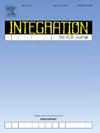O.O: Optimized one-die placement for face-to-face bonded 3D ICs
IF 2.2
3区 工程技术
Q3 COMPUTER SCIENCE, HARDWARE & ARCHITECTURE
引用次数: 0
Abstract
As the miniaturization of integrated circuits (ICs) reaches its physical limits, the industry is entering a “more-than-Moore” era, demanding new Electronic Design Automation (EDA) tools. Existing TSV-based 3D placers focus on minimizing cuts while burgeoning F2F-bonded ICs feature dense interconnection between two planar die. Towards this novel structure, we proposed an integrated adaptation methodology upon mature one-die-based placement strategies. First, we instructively utilized a one-die placer to provide a statistical looking-ahead net diagnosis. The netlist henceforth shall be coarsened topologically and geometrically using a multi-level framework. Our multi-objective gain formulation guides a level-by-level refinement of the partition. This formulation considers factors like cut expectation, heterogeneous row heights, and balanced cell distribution, enabling efficient incremental calculations at each level. Given the partition, we synchronized the behavior of analytical planar placers by balancing the density and wirelength objective function among asymmetric layers. Finally, the result will be further improved by heuristic detail placement of bonding terminals and a post-place partition adjustment. Experimental results demonstrate that our fine-grained fusion of partitioning and placement techniques are competitive compared with the top three winners of the 2022 ICCAD CAD Contest, achieving the best normalized average wirelength with competitive runtime under various 3D architectural constraints.
O.O .优化了面对面键合3D集成电路的单模放置
随着集成电路(IC)的微型化达到物理极限,该行业正在进入一个 "超越摩尔 "的时代,需要新的电子设计自动化(EDA)工具。现有的基于 TSV 的 3D 贴片机侧重于最大限度地减少切割,而新兴的 F2F 粘合集成电路则以两个平面芯片之间的密集互连为特色。针对这种新型结构,我们在成熟的基于单裸片的贴片策略基础上提出了一种集成适应方法。首先,我们指导性地利用单晶片贴片机提供了一种统计前瞻性网络诊断。此后,我们将利用多层次框架对网表进行拓扑和几何粗化。我们的多目标增益公式指导着分区的逐级细化。该公式考虑了切割期望、异质行高和均衡单元分布等因素,从而实现了每一级的高效增量计算。在分区的基础上,我们通过平衡非对称层的密度和线长目标函数,同步了分析平面布局器的行为。最后,通过对接合端子的启发式细节放置和放置后的分区调整,进一步改进了结果。实验结果表明,与 2022 年 ICCAD CAD 竞赛的前三名获奖者相比,我们的细粒度分区与布局技术融合具有很强的竞争力,在各种三维架构约束条件下,我们实现了最佳归一化平均线长,运行时间也很有竞争力。
本文章由计算机程序翻译,如有差异,请以英文原文为准。
求助全文
约1分钟内获得全文
求助全文
来源期刊

Integration-The Vlsi Journal
工程技术-工程:电子与电气
CiteScore
3.80
自引率
5.30%
发文量
107
审稿时长
6 months
期刊介绍:
Integration''s aim is to cover every aspect of the VLSI area, with an emphasis on cross-fertilization between various fields of science, and the design, verification, test and applications of integrated circuits and systems, as well as closely related topics in process and device technologies. Individual issues will feature peer-reviewed tutorials and articles as well as reviews of recent publications. The intended coverage of the journal can be assessed by examining the following (non-exclusive) list of topics:
Specification methods and languages; Analog/Digital Integrated Circuits and Systems; VLSI architectures; Algorithms, methods and tools for modeling, simulation, synthesis and verification of integrated circuits and systems of any complexity; Embedded systems; High-level synthesis for VLSI systems; Logic synthesis and finite automata; Testing, design-for-test and test generation algorithms; Physical design; Formal verification; Algorithms implemented in VLSI systems; Systems engineering; Heterogeneous systems.
 求助内容:
求助内容: 应助结果提醒方式:
应助结果提醒方式:


